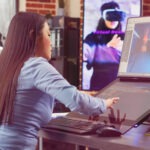AI - The Job Killer or Creator of a Creative Renaissance?
- May 9, 2023
Over the past few years, the rise of artificial intelligence (AI) has sparked both excitement and concern about its potential impact on jobs. While there is no doubt that AI will transform many job roles, the question remains whether it will take away jobs or create new ones. In the fields of copywriting and art direction, AI is already making its presence felt, but its impact is likely to be more transformative than destructive.
One of the key ways in which AI is transforming copywriting is by automating the process of content creation. AI-powered tools like ChatGPT and Midjourney are able to generate high-quality content at scale, from product descriptions to blog posts. This means that copywriters will no longer need to spend hours brainstorming ideas or researching topics, freeing up time to focus on more strategic work like developing brand messaging and creating compelling narratives.
However, AI is not a replacement for human creativity. While it can generate content based on data and algorithms, it cannot replicate the nuance and emotional resonance of a well-crafted piece of writing. As such, copywriters will need to learn how to work alongside AI tools, using them to streamline their workflow and enhance their output rather than viewing them as a threat.
Moreover, the rise of AI is creating new job roles in the field of copywriting. As AI-generated content becomes more prevalent, companies will need copywriters who can curate and edit this content, ensuring that it aligns with brand guidelines and resonates with target audiences. In addition, copywriters will be needed to develop new content formats and styles that are specifically designed to take advantage of the capabilities of AI tools, such as chatbots and virtual assistants.
Similarly, AI is transforming the field of art direction by enabling creatives to explore new possibilities and push the boundaries of what is possible. AI-powered tools like Adobe Sensei can automate tasks like color correction and image tagging, allowing designers to focus on more complex and creative work. In addition, AI can help designers generate new ideas and concepts, providing inspiration and expanding their creative horizons.
At the same time, AI is not a replacement for human creativity in art direction either. While AI can help designers to work more efficiently and effectively, it cannot replicate the unique perspective and artistic vision of a human designer. As such, designers will need to learn how to collaborate with AI tools, using them to enhance their creative output rather than viewing them as a replacement.
In addition, the rise of AI is creating new job roles in the field of art direction. As AI-powered tools become more prevalent, companies will need designers who can incorporate these tools into their creative workflows, developing new styles and techniques that take advantage of the capabilities of AI. Moreover, designers will be needed to oversee the creative output of AI tools, ensuring that it aligns with brand guidelines and resonates with target audiences.
Popular Posts
-
 Future-Proofing Talent: Skills Digital Agencies Will Need Tomorrow25 Apr 2024
Future-Proofing Talent: Skills Digital Agencies Will Need Tomorrow25 Apr 2024 -
 The Future of Leadership in Digital Agencies – Adapting to Changing Dynamics19 Apr 2024
The Future of Leadership in Digital Agencies – Adapting to Changing Dynamics19 Apr 2024 -
 Navigating UAE's Digital Frontier: A Pro's Guide to Success18 Apr 2024
Navigating UAE's Digital Frontier: A Pro's Guide to Success18 Apr 2024 -
 Eid Influencer Collaboration Dos and Don'ts: Maximizing Impact and Authenticity04 Apr 2024
Eid Influencer Collaboration Dos and Don'ts: Maximizing Impact and Authenticity04 Apr 2024






